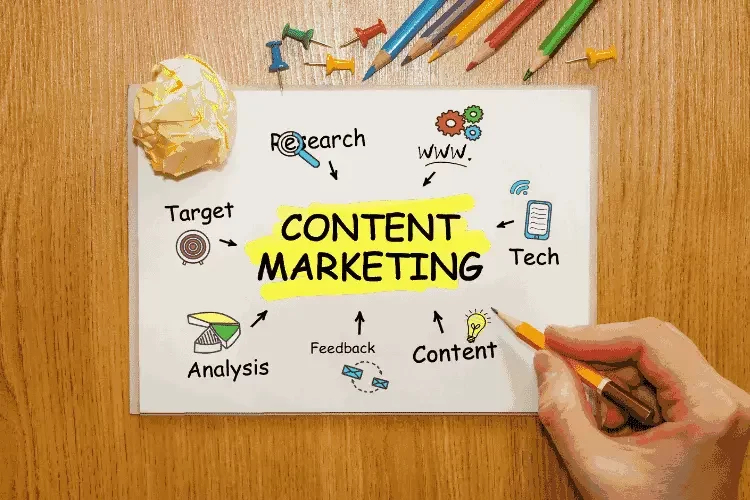
A marketing strategy includes several moving parts, of which content marketing is just one. Moreover, a marketing plan should detail which content should be distributed to which demographics and channels. The content is the medium through which search engine optimization, paid search advertising, and social media marketing is implemented.
The content marketing ethos appears to be “more of the same,” which isn’t great for SEO. Moreover, this highlights the need to have a solid content marketing strategy. It encompasses internet advertising’s long-term aims, including new digital content production and improvement. Content marketing success depends on high-quality content relevant to the intended audience. People must receive and respond to the content as intended. There is a direct correlation between the cost of internet and social media contacts and the importance of having great content.

To provide a clear roadmap for content development, your Content Marketing Strategy should detail your goals, plans, and activities. We’ve laid down a simple 7-step plan for creating your content marketing plan:
The first step in any planning process is identifying the result you hope to achieve. Moreover, having a defined objective makes it simpler to evaluate the performance of your content marketing efforts and sharpens your focus.
Increasing revenue, marginal returns, or profits are all examples of business objectives that inform a content marketing strategy. Improving the website’s conversion rate or getting more visitors to stay on the page are two examples of more narrowly focused e-commerce targets. Moreover, brand recognition and search engine rankings are just two examples of broad marketing and online marketing objectives that could form the backbone of a successful Content Marketing Strategy.
Creating content with distinguishable features is also a key objective. To stand out from the competition, your material needs to highlight what makes your business, brand, team, and goods exceptional.
Your goal should be “S.M.A.R.T.,” that is
The internet has reached the majority of the world’s population. Attempting to please everyone’s tastes is impossible. Moreover, if you don’t know who you’re writing for, you can’t expect your content to resonate with them or be successful. Furthermore, understanding and identifying your intended audience is crucial.
The greater the effort put into analyzing and segmenting your target audience and using their demands and segment specs as the basis for your Content Marketing Strategy, the better the results of your content marketing efforts will be. For instance, do you know which devices your readers use? Have you analyzed the most often used keywords or the most talked about subjects on social media? These and other characteristics of your target audience provide a solid basis for building engaging and informative content.
Limiting yourself to one demographic is unnecessary: There may be synergy between different target audiences depending on your objective. There can be both a primary and secondary audience that you’re writing for and hoping to engage with your latest posts. To better tailor the material, you should reflect your target audience in personas. Writing for a single, well-defined reader is much less daunting than writing for a broad, faceless audience.
Use the proper analysis techniques to identify and categorize the target audience. You can learn a lot from tools like Google Analytics and Facebook Insights. It takes more time and energy, but the results of a customer survey conducted via email, in person, or over the phone are well worth it.

Before making any new material, you should stock what you already have. A content audit is what the industry calls it. That means everything you’ve ever published is cataloged, providing a comprehensive overview of your content and its effect on your audience. Auditing content can also help you spot areas where optimization could be improved.
Once you have a firm grasp of your material, it is time to evaluate the competition in light of your established objectives and demographics.
To begin, select at least three rivals. Moreover, you may find out who your biggest rival is by searching on Google. To do this, search your rivals using the same set of terms that you and your target audience employ. Rival businesses must discuss similar issues. Once competitors have been chosen, it’s time to examine their published content and keep in mind things like:
Is there content on the web that your rivals have created that is similar to your own or covers an entire topic you haven’t? Learn to set yourself apart from the competition and how to provide superior content.
Using a C.M.S. (Content Management System) helps improve the content management processes in your organization. That’s why organizing, producing, and evaluating content is important. The goal with the right C.M.S. is to gain a higher overview level, just like with content audits. By establishing regular editing sessions, you can gauge the response to new postings and refine your strategy accordingly.
Use a tool like Google AdWords Keyword planner to learn when is the ideal time to release content related to seasonal topics. By doing so, you can learn when interest in a particular topic, say, “changing tyres,” is at its peak in search volume. Content management system stores important data.
It takes a lot of time and money to create high-quality content. Because of this, it’s crucial to have a strategy for creating and releasing content over a prolonged period. Your content marketing plan will be useful in this regard as well.
A content calendar can help you plan out the best times to publish your content and the best times to write about seasonal topics. Moreover, topic scheduling is a useful tool for managing long-term output. There needs to be plenty of planning and production before any major events with a finite runtime.

The final stage is to evaluate the impact of your content. Is Google naturally expanding your horizons? Does YouTube see an uptick in subscribers? Do visitors see your website or storefront as something special? Moreover, regular reviews of these and other objectives will allow in-depth analysis of your content metrics.
Google Analytics, for instance, provides a high-level perspective, but each social media platform also has its analytics tools. It’s important to maintain a healthy skepticism, as positive outcomes can be influenced by spam and other similar practices.
A focused Content Marketing Strategy is worth the time and effort it takes to create and use. Moreover, your efforts will pay off with highly useful content that performs well in search engine rankings.
We provide online certification in Data Science and AI, Digital Marketing, Data Analytics with a job guarantee program. For more information, contact us today!
Courses
1stepGrow
Anaconda | Jupyter Notebook | Git & GitHub (Version Control Systems) | Python Programming Language | R Programming Langauage | Linear Algebra & Statistics | ANOVA | Hypothesis Testing | Machine Learning | Data Cleaning | Data Wrangling | Feature Engineering | Exploratory Data Analytics (EDA) | ML Algorithms | Linear Regression | Logistic Regression | Decision Tree | Random Forest | Bagging & Boosting | PCA | SVM | Time Series Analysis | Natural Language Processing (NLP) | NLTK | Deep Learning | Neural Networks | Computer Vision | Reinforcement Learning | ANN | CNN | RNN | LSTM | Facebook Prophet | SQL | MongoDB | Advance Excel for Data Science | BI Tools | Tableau | Power BI | Big Data | Hadoop | Apache Spark | Azure Datalake | Cloud Deployment | AWS | GCP | AGILE & SCRUM | Data Science Capstone Projects | ML Capstone Projects | AI Capstone Projects | Domain Training | Business Analytics
WordPress | Elementor | On-Page SEO | Off-Page SEO | Technical SEO | Content SEO | SEM | PPC | Social Media Marketing | Email Marketing | Inbound Marketing | Web Analytics | Facebook Marketing | Mobile App Marketing | Content Marketing | YouTube Marketing | Google My Business (GMB) | CRM | Affiliate Marketing | Influencer Marketing | WordPress Website Development | AI in Digital Marketing | Portfolio Creation for Digital Marketing profile | Digital Marketing Capstone Projects
Jupyter Notebook | Git & GitHub | Python | Linear Algebra & Statistics | ANOVA | Hypothesis Testing | Machine Learning | Data Cleaning | Data Wrangling | Feature Engineering | Exploratory Data Analytics (EDA) | ML Algorithms | Linear Regression | Logistic Regression | Decision Tree | Random Forest | Bagging & Boosting | PCA | SVM | Time Series Analysis | Natural Language Processing (NLP) | NLTK | SQL | MongoDB | Advance Excel for Data Science | Alteryx | BI Tools | Tableau | Power BI | Big Data | Hadoop | Apache Spark | Azure Datalake | Cloud Deployment | AWS | GCP | AGILE & SCRUM | Data Analytics Capstone Projects
Anjanapura | Arekere | Basavanagudi | Basaveshwara Nagar | Begur | Bellandur | Bommanahalli | Bommasandra | BTM Layout | CV Raman Nagar | Electronic City | Girinagar | Gottigere | Hebbal | Hoodi | HSR Layout | Hulimavu | Indira Nagar | Jalahalli | Jayanagar | J. P. Nagar | Kamakshipalya | Kalyan Nagar | Kammanahalli | Kengeri | Koramangala | Kothnur | Krishnarajapuram | Kumaraswamy Layout | Lingarajapuram | Mahadevapura | Mahalakshmi Layout | Malleshwaram | Marathahalli | Mathikere | Nagarbhavi | Nandini Layout | Nayandahalli | Padmanabhanagar | Peenya | Pete Area | Rajaji Nagar | Rajarajeshwari Nagar | Ramamurthy Nagar | R. T. Nagar | Sadashivanagar | Seshadripuram | Shivajinagar | Ulsoor | Uttarahalli | Varthur | Vasanth Nagar | Vidyaranyapura | Vijayanagar | White Field | Yelahanka | Yeshwanthpur
Mumbai | Pune | Nagpur | Delhi | Gurugram | Chennai | Hyderabad | Coimbatore | Bhubaneswar | Kolkata | Indore | Jaipur and More